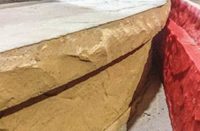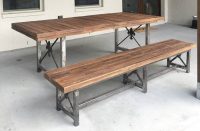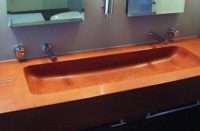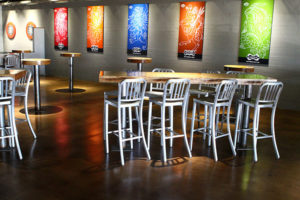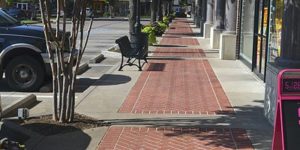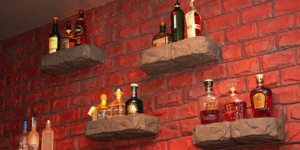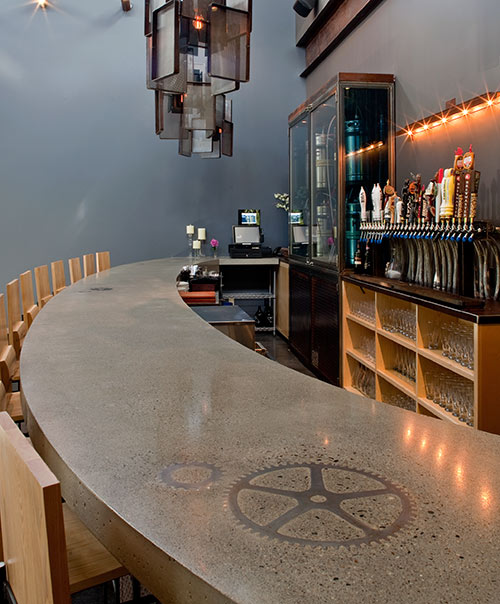
While most New Englanders today are keeping their purse strings drawn tight and few are investing in concrete countertops for their homes, it’s a different story for area restaurants that serve drinks, says Michael Littlefield, owner of Custom Concrete Design in North Berwick, Maine.
“The drinking business is booming in these lean times and we’ve been doing a lot of bar tops,” Littlefield says. “In years past, we may have done one a year but last year we did five.”
And not just five run-of-the-mill colored concrete countertops either, he adds. All are one-of-a-kind creations with unique features such as inlaid gears, embedded chunks of demolished concrete and recessed wells for floating candles.
Among the five are counters for When Pigs Fly, an upscale pizzeria and bread shop in Kittery, Maine, The District, a restaurant in Portsmouth, N.H., and Demeter’s Steakhouse, in the Regeneration Park development in Portsmouth.
“Most of our clients are letting us have free creative rein with our designs,” Littlefield says, “but that was not the case in the Pigs Fly project. They had a good idea of what they wanted before we came into the picture. They wanted something simple with clean lines.”
Littlefield says he’s used a lot of cementitious countertop mixes and other systems over the years with varying results, but for his purposes, nothing beats good old-fashioned traditional concrete. “We’ve gone back to using the real thing — cement, stone, sand and water — and have had the best results. We try to keep it as real as possible with 4,000 psi ready-mix from the truck and 3/8-inch stone.”
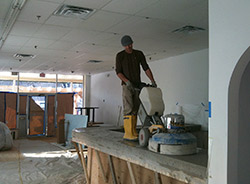
The only things he adds to create his standard countertop mix are integral color, a densifier and the know-how acquired through 16 years of decorative experience.
Once the mixture is poured, he lets it set for about a month before beginning the grinding and polishing, which normally only takes a couple of days. For that, Littlefield says, he typically uses a small 300-pound stand-up planetary grinder, the same one he uses on floors. “I just stand on the bar and run the machine,” he says.
The finish he achieves is highly polished and stain-resistant. “We do have some trade secrets, which I discovered through trial and error,” Littlefield says. “We achieve the results we get through a proprietary stain-resistant process used to seal the bar top.”
Bar Top at When Pigs Fly Kittery, Maine
When Michael Littlefield met with the designer of the When Pigs Fly project to show samples of his work, one project with steel gears embedded in the concrete caught the designer’s eye. Turned out there were some antique cast-iron gears on hand.
The restaurant’s décor is very masculine, Littlefield says of the upscale pizzeria and bread shop in Kittery, Maine, that features microbrews on tap and an extensive wine list. “There’s steel showing everywhere you look and gray concrete floors,” he says. “I wanted to warm things up a bit but the designer fought me on that. He had a vision he was pretty well set with.”
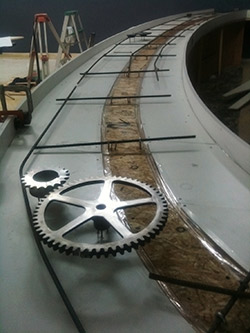 Even though this project is new construction, it doesn’t look that way. Recycled materials are rampant. Exposed steel beams with their dimensions scrawled on them are clear-coated to emulate an industrial look. Recycled rusty steel pieces are incorporated into the cabinetry and new framework is left unpainted. And then there’s the bar.
Even though this project is new construction, it doesn’t look that way. Recycled materials are rampant. Exposed steel beams with their dimensions scrawled on them are clear-coated to emulate an industrial look. Recycled rusty steel pieces are incorporated into the cabinetry and new framework is left unpainted. And then there’s the bar.
“I used my own blend of color to make it look like concrete used to before they started adding in fly ash and other things that lighten the gray,” Littlefield says. Blending an L. M. Scofield charcoal dye with titanium dioxide powder helped him achieve the deeper gray hue he wanted.
Littlefield was able to modify the proposed shape of the bar into one with “a nice clean curve. There were some strange curves in it before,” he says. Along with this alteration, the designer also went along with Littlefield’s recommendation to increase the thickness from 2 inches to 3. “The thicker, the better,” Littlefield says. “It just makes it that much more impressive.”
Littlefield had the designer’s three-dimensional cast-iron gears planed by a machinist to create flat-top pieces that were inlaid into the bar top. “That part was a bit of a challenge,” he says. “We had to get the gears as close to the surface as possible as the designer wanted a minimal grind with very little aggregate showing on top.”
As for the grinding process, he started with a 50-grit resin diamond and took it up to 1,500. “We did a 50, 100 and 200 wet and then slurried to fill in the voids. We finished with a 400, 800 and 1,500 dry. We didn’t use any metal diamonds.”
The cast-in-place 35-foot-long bar top was completed on time without a glitch. The hardest part, Littlefield says, was doing the initial wet grind in an almost finished space. “That was probably the most challenging aspect of this job. We had to mask everything off and contain all the water. We should have been in there sooner. Besides that, it couldn’t have gone any better.”
Project at a Glance
Client: When Pigs Fly, an upscale pizzeria and bread shop in Kittery, Maine
Contractor: Custom Concrete Design Inc., North Berwick, Maine
Scope of project: Build a seamless 35-foot-long by 30-inch-wide by 3-inch-thick cast-in-place bar top with inlaid antique gears
Materials Used: Local ready-mix concrete with 3/8-inch aggregate; L. M. Scofield Co. integral-coloring dye in a charcoal color blended with titanium dioxide
